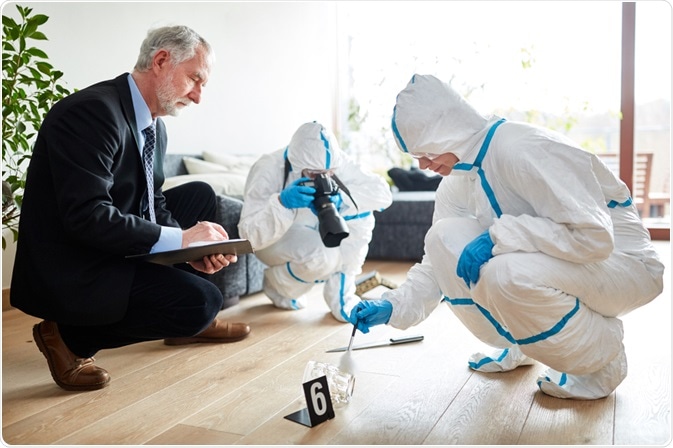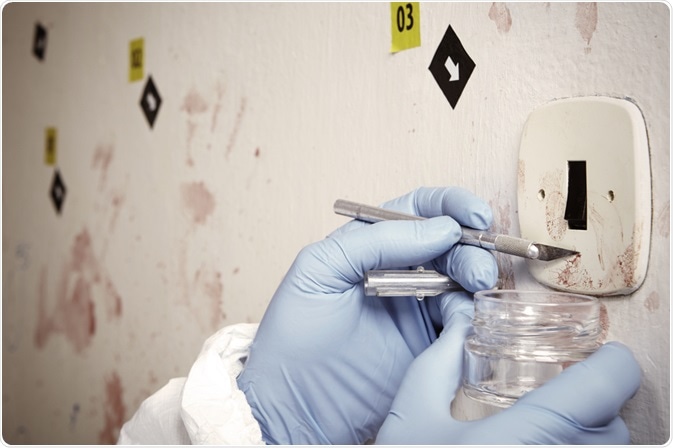The field of forensic science is defined as the ‘application of science to a court of law.’ Seeking truth in a legal proceeding relies heavily on the objective and sophisticated forensic analysis to serve justice as the chronology of events can be reconstructed from the evidence that is analyzed.

Image Credit: Robert Kneschke/Shutterstock.com
Hence, analytical chemistry is a useful avenue to provide the qualitative and quantitative identification of an unknown sample in various forensic science disciplines through various techniques.
Analytical Chemistry in Forensic Toxicology
Forensic toxicology studies the effects of poisons and drugs on the human body. Common cases are drinking under the influence, wildlife poisoning, and the manner of death. Analytical chemistry is useful to interpret the effects and quantify the concentration of the chemicals present in biological specimens to provide reliable data.
Hair, nails, urine, blood, and brain tissue are useful biological specimens for forensic toxicologists to draw interpretations of various cases. Analytes are to be extracted from these biological specimens to be identified by different instruments. GC-QMS is an efficient instrument to quantify and identify the chemical components present in blood and urine from the analytes extracted.
The concentration of the analyte can be measured by the method of internal standard and a calibration curve. While screening for specific substances can be done by observing the common ions that exist in the compounds collected.
LC-MS is another common instrument used in drug-testing laboratories by analyzing the analytes in liquids, such as the presence of cocaine in oral fluid and risperidone in plasma. The instrument relies on the separation of compounds in the stationary and mobile phases to identify individual components in complex biological samples.
Analytical Chemistry in Arson
Forensic science laboratories are in charge of investigating the crime of setting fire to a property based on the cause and if the crime indeed occurred. The role of chemicals plays a huge role as they could be utilized to embark or increase the spread of fire to the property.
A common chemical with this ability is called "accelerants" and they can be used to promote the fire to generate more heat and consume existing fuels more rapidly.
Analyzing the presence of ignitable liquids in traces from fire debris can serve as an indicator if the fire is accidental, or resulting from arson when it contains an accelerant. Arson analysts have done this through a comparative analysis of the extracted recovered sample with the reference standards.
The data used for this analysis is done through the chromatograms obtained from GC-MS. The chemical components present in the extracted fire debris sample can be characterized through the functional groups identified along with a total ion count for the highest peak in the chromatogram.
The total ion chromatogram shows all the compounds present and is useful to assign the ignitable liquid in different classes through examining particular diagnostic patterns and their boiling point ranges.
Database searches from the mass chromatograms can then confirm the nature of the relevant peaks. While relative abundance of the chemical components indicates the presence of mixtures and the ignitable liquid class the compound belongs to.

Image Credit: Bilanol/Shutterstock.com
Analytical Chemistry in Drug Analysis
Medical examiners observed that illicit drugs have caused 750,000 deaths in a year. The prolonged usage of these drugs causes harm to public health and community security as violence is commonly involved in the process of drug dealing. Law enforcement has implemented controls in illicit drug use to protect the community from thefts, burglaries, and gang-related crimes.
A range of evidence varying from liquids, solids to plant materials is submitted to forensic science laboratories to analyze the drug samples collected. The procedure involves physical analysis such as the volume, weight, and unit count.
The process of screening to detect the drugs by chemical spot tests would then be conducted, followed by confirmation tests, where GC-MS is commonly used. The target compounds can be detected by the retention times compared with the standards.
Unknown compounds can also be determined by the mass spectrometry once the components have been separated. Aside from the GC-MS instrument used by forensic testing laboratories, HPLC, UV-Vis, and FTIR are also useful analytical instruments that can complement the frequent method.
Analytical Chemistry in Trace Evidence
Trace evidence in forensic science stands on the Locard's exchange principle, "whenever two objects come into contact with one another, an exchange of materials occurs between them." The trace material can be used to link a crime scene and/or a victim to a potential perpetrator through comparative analysis.
These types of evidence exist in traces and cannot be seen by the naked eye. Common examples of trace evidence are glass, fiber, paint chip, gunshot residue, soil, body fluids, and hair.
The characterization of trace evidence requires knowledge of analytical chemistry as the results obtained can be in the quantitative form, by how much samples are recovered, or qualitative form, the identity of the trace material. Characterizing trace materials include examining both physical and chemical properties.
The physical analysis begins with a visual examination to assign the evidence to a specific class. This is then followed by the chemical analysis of identifying chemicals in the material through analytical instruments such as infrared spectroscopy, GC-MS, DART-TOFMS.
The instrumental methods of analysis vary depending on the type of evidence encountered. For instance, glass requires the Glass Refractive Index Measurement System (GRIM) method of analysis on quantifying the refractive index of two pieces of glass to determine if they come from the same source.
While the characterization of fibers, such as how they are manufactured, cross-sectional shape, and color, can be done by utilizing the instruments FT-IR, PLM, and/or stereomicroscope.

Image Credit: Couperfield/Shutterstock.com
What is analytical chemistry?
References:
- Drummer, O., et al (2013) ‘Forensic drug analysis’. Forensic Drug Analysis, pp. 2-9. https://research.monash.edu/en/publications/forensic-drug-analysis-2
- Mikulewicz, M., et al. (2014) ‘How Toxicology Impacts Other Sciences’, Encyclopedia of Toxicology, 3(4), pp. 746 – 749. https://www.researchgate.net/publication/261711214_How_Toxicology_Impacts_Other_Sciences
- New Jersey State Police. n.d. Trace Evidence Analysis [Online] Available at https://www.njsp.org/division/investigations/trace-evidence.shtml (Accessed 23 June 2020).
- Ritchie, H., and Roser, M., 2018. Opioids, Cocaine, Cannabis, And Illicit Drugs. [Online] Our World in Data. Available at: https://ourworldindata.org/illicit-drug-use (Accessed 24 June 2020).
- Smith, M., et al. (2009) ‘Modern Instrumental Methods in Forensic Toxicology’, Journal of Analytical Toxicology, 31(5), pp. 237–9A. https://www.ncbi.nlm.nih.gov/pmc/articles/PMC2745311/
- Smith, R. (1982) ‘Arson analysis by mass chromatography’, Analytical Chemistry, 54(13), pp.1399A-1409A. https://pubs.acs.org/doi/abs/10.1021/ac00250a751
- Singh, Z. (2017) ‘Forensic Toxicology: Biological Sampling and use of Different Analytical Techniques’, Forensic Research & Criminology International Journal, 4(4). https://medcraveonline.com/FRCIJ/forensic-toxicology-biological-sampling-and-use-of-different-analytical-techniques.html
Further Reading
Last Updated: Nov 4, 2024